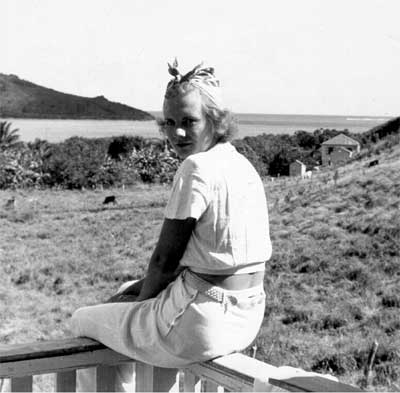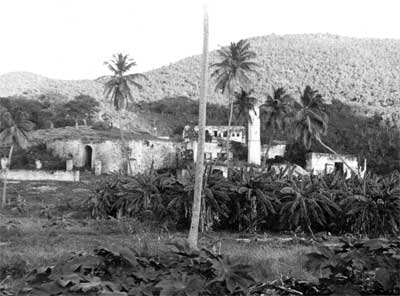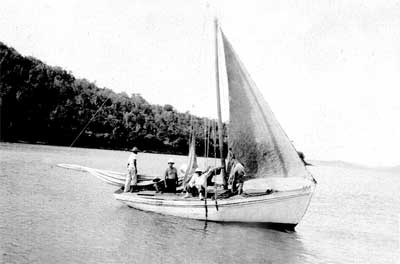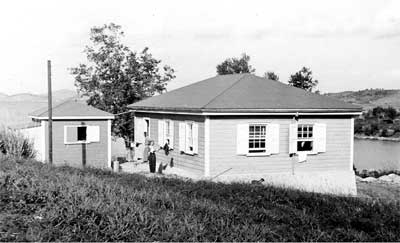A Remembrance of St. John by Anna W. Knight, c1987

Anna (Billy) Wolmer Knight
(Photo courtesy of David Knight)
Edited and condensed by David Knight-2009
(Anna Wolner Knight (affectionately known to most folks on St. John as “Billy”) was the Mother of board member David Knight. She was born in New York in 1911, the first child of recently-arrived German immigrants. At the age of 19 she married Dr. George H. H. Knight and settled into life as the socialite-wife of a prominent Westchester dentist. Dr. Knight, however, loved to wander. While on an extended sojourn through the West Indies in 1934, Knight was invited by the Danish Counsel on St. Thomas to accompany him on a trip to St. John for a dinner aboard the Danish training ship “Danmark”, which was anchored off Caneel Bay. Before leaving St. John, Dr. Knight was told of plans to build rental cottages for tourists at Caneel Bay. Impressed by the tranquil beauty of the island, Knight pledged that as soon as a cottage was built he would return to St. John. And indeed, in 1936, accompanied by his 25-year-old wife, Billy, the Knights were among the very first guests at Caneel Bay Resort. Billy‘s remembrances, along with photographs taken by both her and husband George, portray a time of discovery, innocence and wonder, still shared by new visitors to St. John to the present day; St. John is not new to capturing romantic hearts.)
We awake under our mosquito nets to the sound of a cock crowing somewhere behind the ruins of the horse mill and sugar house at Caneel Bay. Above us, upside down on the ceiling, a gecko lizard dashes out after an unsuspecting insect. It is dawn and soon Darcus will come over the hill riding her donkey, work shoes tied around her neck by the laces. She will go to the back-yard cook house to do the laundry, and while it drip dries on bushes and wire fencing she will sit on the back steps smoking her corn-cob pipe. Then, piece by piece, she will do the ironing with a charcoal “goose.”

Caneel Bay Ruins
(Photo courtesy of David Knight)
We sip our morning coffee on the gallery overlooking the sea grape fringed beach and a harbor of turquoise water. Little black and yellow sugar birds, bananaquits, fly in and help themselves to the contents of our sugar bowl. Trade winds rustle the banana leaves blending with the sound of the ebb and flow of waves on the shore. Later, young men in small boats come from Frenchtown on St. Thomas to cast their nets in the harbor and we buy colorful fish with strange names for Iantha to prepare for lunch.
In the afternoon, ground doves scatter at the sound of our horse‘s hooves as we ride over the hill to Cruz Bay; a great blue heron flies up, legs dangling, from the mangroves that line the Cruz Bay waterfront. Had it been blown off course on its long flight from a summer in Maine to Trinidad? We visit the country store with its large wheels of cheese and barrels of lard and salted codfish. Or perhaps we visit the commissioner and his wife who live at the old Danish fort known as the Battery.
This was 1936 on the island of St. John, U.S. Virgin Islands. In those days the commissioners of the island were required to be doctors as well as heads of local government. Dr. Hughs was a friendly, pink-cheeked, white-haired gentleman, who wore a white pith helmet while making his rounds of the island astride a white horse. I remember that he rode up Centerline Road to a wedding in the Moravian Church at Bethany, while Mrs. Hughs walked with us. I also remember that I wore a lavender afternoon dress, a flowered hat with a veil and saddle shoes.

St. John, an island of approximately five hundred indigenous folk and perhaps nine continentals in 1936, was considered an escapists utopia. On this island of five by nine miles of overgrown bridle paths, deserted pristine beaches and few visitors, a mail boat arrived once a week. There were no roads, in fact no wheels, and a choice for exploring was a horse, a donkey, or on foot. Little thought was given by a visitor to the crumbling ruins of ancient great houses hidden behind a tangle of bush, strangler figs, thorn acacia and catch-and-keep, or to the appalling events that had taken place there during the uprising of slaves in 1733-1734.
For those of us who rode the trails the rewards were spectacular views and deserted beaches. We learned to make ice cream with the soursop, to flip the seeds of the sugar apple, to eat mangos and guava, and to cook the green papayas for lunch and eat the ripe ones for breakfast. We used bananas in every way we could think of and we ate cassava bread and the jelly of green coconuts with a spoon. There were reef fish in startling hues — parrotfish, angel fish, butterfly fish and the flat-bottomed hard-shelled trunk fish that could be cooked over a charcoal pot — caught in fish pots woven from palm fronds. There were no telephones, and the only electricity at Caneel Bay was supplied by their own generator.
We had Christmas dinner that year as guests of Mr. Thrigo, the Caneel Bay plantation manager and his wife and daughter Elsa. Though the United States had purchased the Virgin Islands from Denmark in 1917, and the name of St. John had been changed from St. Jan, the cultural influence throughout the Virgin Islands remained charmingly Danish.
The world as we knew it had been left behind and we especially felt this to be true on a trip to Tortola, British Virgin Islands. Capt. Billy owned a small island sloop which he used to transport goats and charcoal, and whatever else he needed to carry. We “chartered” Capt. Billy and his boat for a trip to Tortola. Becalmed off Mary‘s Point I tried to sleep stretched out on a dirty old sail where I overheard a discussion between our house boy and a member of the crew about live ghosts, werewolves and jumbies.

Capt. Billy‘s Sloop
(Photo courtesy of David Knight)
A visitor to St. John was Professor Robert Woodworth, on sabbatical from Bennington College to study plants and animals and marine life. We went on a field trip with him and I found myself very much involved with the study of tide pools and reefs. This was before scuba diving and we wore water goggles and a diving bell that rested on our shoulders. A whole new world was opened to me and became a life-long interest. Sometimes we would row out to Carvel Rock to fish for yellow tail or just sit and watch for migratory whales.
A trip from Cruz Bay to Coral Bay over the paved Centerline Road takes about twenty minutes today, but in 1936 the round trip was more comfortably made in two days. We would ride the narrow overgrown trail until it reached the Bordeaux overlook, where we would dismount and walk our horses down the steep and rocky trail to Coral Bay. A quiet little settlement, Coral Bay‘s one claim to fame was a primitive little still where leaves of the bay trees that grew on Bordeaux Mountain were processed for oil. Mixed with alcohol it became Bay Rum.
On a wall of the Elaine Sprauve Cruz Bay library today a picture hangs of two women and a man on horse back, riding the Centerline trail — I am one of the women. It pleases me that I am able to prove that I was once young enough to ride a horse!
Today Caneel Bay is known as an exclusive playground for the rich and often very famous. It grew into this only after World War II, but even before the war, in response to Desmond Holdridge‘s book “Escape to the Tropics”, some well known folks were already discovering our island paradise. As the West India Company expanded on their Caneel Bay Plantation by adding cottages on the [northern] point, we moved with them. In 1936 we had been the first tenants in the first cottage which was placed on a knoll overlooking the beach. The newer cottages on the point had wrap-around galleries and two bedrooms, but still had a cook house out back where one had to keep the door closed against the resident raider, the mongoose.
We found ourselves the following winter with interesting neighbors. Robert Ripley (Believe it or Not) and his male secretary were in Cottage #4. Mr. Ripley was regarded by the locals as “not quite right”. He would wear a black wool turtleneck sweater and run the hilly trails. Jogging had not been heard of on St. John!

Caneel Bay, Cottage No. 1
(Photo courtesy of David Knight)
Leon Henderson, Director of President Roosevelt‘s OPA was in Cottage #5. Leon liked canned shad roe with his scrambled eggs, which I prepared for him before he and George went deep sea fishing for king fish with Rudi and Ernest of Lovango Cay.
There were evenings spent on board the Danish training ship, Danmark, with Capt. Hanson, who had found St. John an ideal place to give his young crew shore leave. The stars, without competition, would be unbelievably bright as we sat on deck and studied them.
Today bananaquits still steal your sugar, humming birds visit your hibiscus, and African Tulip trees bloom. African Guinea grass thrives where sugar cane once grew and the hee-haw of donkeys can still be heard in the hills – but now they are homeless and wild, and some wear radio tracking collars, and no one seems to know what to do about them. The Commissioner, who is now called the Administrator, still lives in the old Danish fort, the Battery, but he is no longer required to be the island doctor. There are hourly ferries and visitors from all over the world — hikers, campers, day visitors and people who buy condos and stay. The little town of Cruz Bay suffers from progress with restaurants, bars, boutiques, liquor stores and all the services that free enterprise can offer, including a pick up and deliver laundry. All this because on December 1, 1956, Laurence Rockefeller, as a gift to the Federal Government, handed Secretary of the Interior Seaton the deed to approximately two thirds of the island of St. John. Our little island paradise became the first tropical United States National Park. In 1962 Congress added offshore areas to the Park as well.
Now, fish pots are no longer permitted over protected reefs, and life guards stand watch on once-deserted beaches. Sea turtles and their eggs are protected with heavy fines and even jail for offenders. The Audubon Society plans birding trips, the Historical Society plans hikes to plantation ruins and schedules archaeologists as speakers for their meetings, and a yacht club plans regattas. There are telephones, electricity, TVs, taxis, safari buses, boats to charter and jeeps to rent. A letter I have received from Secretary Potter of the National Park Service of Cruz Bay, dated December 7, 1987, informs me that “the annual average number of visitors to the Park in the last five years has been 1,115,920 persons”. The little island that had once been enjoyed by so few is now being enjoyed by the many.
See the related items:
[Bay rum][Oral history]
| Resource | Title | Attributes |
|---|---|---|
| Article | Bay Rum: A Niche of Distinction in VI History | Schulterbrandt, L.D.N., Gail |
| Article | Childhood Summers Spent on St. John | Sprauve, Gaylord |
| Article | Cruz Bay Christmas Recollections of Andro Childs in the 1930s and 40s | Childs, Andro |
| Article | Mr. Elroy Sprauve Describes His Early Christmas Holidays on St. John | Sprauve, Elroy |
| Article | Post-Plantation and Pre-Tourism: Life and Work on St. John in the Early 20th Century | Fortwangler, Crystal |
| Article | ‘Twas The Night Before Christmas (and Other Bedtime Stories) | Prime, Lolly |
| Article | Boulon Family | Boulon, Rafe |
| Article | Gibney Family | Gibney, Eleanor |
| Article | Lameshure Bay Explore | Knight, David |
| Article | A Family Album by Anna Nose | Swank, Robin |
| Article | Potluck & Storytelling at the SJHS January 13, 2009 Membership Meeting | Swank, Robin |
| Article | A Remembrance of St. John | Knight, Anna |
| Article | Ladies’ Storytelling at Bethany Church Hall, Novemember 10, 2009 | Swank, Robin |
 |
Bay Rum Factory in Coral Bay, 1919 Creator: Tyge Hvass Owner: Royal Library, Copenhagen, Denmark Photograph |
|
 |
Three Kings Day celebration with SJHS Historian Mr. Elroy Sprauve and entertainment by The Sunshine Band Creator: Bruce Schoonover Owner: Bruce Schoonover photomontage |
